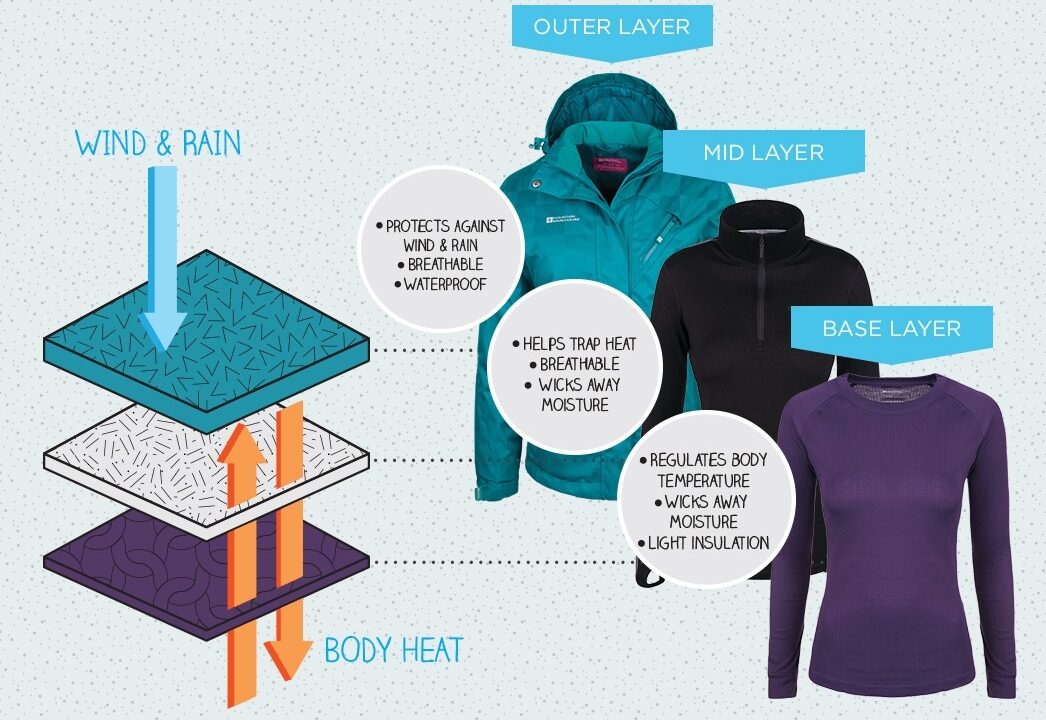

When it comes to hiking, Hiking Clothing Layering Tips is essential for comfort, protection, and adapting to changing weather conditions.
Layering allows you to regulate body temperature, manage moisture, and stay comfortable throughout your hike.
In this article, we will provide you with valuable tips on how to layer your clothing effectively for hiking, ensuring that you are prepared for various conditions and able to fully enjoy your outdoor adventure.
Jump to a Section
ToggleLayering your clothing for hiking provides several benefits:
Temperature Regulation: Layering allows you to add or remove clothing as needed to adapt to changing weather conditions and body temperature. It helps trap and retain heat when it’s cold and allows for breathability and ventilation when it’s hot.
Moisture Management: Layering helps wick away moisture from your body, keeping you dry and comfortable. It prevents sweat from accumulating on your skin, which can lead to discomfort and even hypothermia in cold conditions.
Versatility: Layering provides flexibility and versatility, allowing you to adjust your clothing according to the intensity of your hike and the conditions you encounter. It enables you to stay comfortable and protected throughout your entire hiking experience.
Now let’s explore the different layers and their specific functions.
The base layer is the layer closest to your skin and serves as the foundation of your clothing system. Here are some key considerations for the base layer:
Material Selection
Choose a base layer made of moisture-wicking and quick-drying materials such as merino wool or synthetic fabrics like polyester or nylon. These materials help pull moisture away from your skin, keeping you dry and comfortable.
Moisture Management
The base layer’s primary function is to manage moisture. It should fit snugly but not be too tight, allowing for proper airflow and moisture transfer. Avoid cotton, as it retains moisture and can leave you feeling cold and clammy.
The mid-layer provides insulation and warmth. Here’s what to consider for the mid-layer:
Insulation and Warmth
Choose a mid-layer that provides warmth without adding excessive bulk. Fleece jackets, synthetic insulated jackets, or down jackets are common choices. The insulation should be breathable and provide sufficient warmth for the expected weather conditions.
Breathability
The mid-layer should allow moisture to escape from the base layer and prevent overheating. Look for materials that offer good breathability, allowing sweat and excess heat to evaporate.
The outer layer, also known as the shell layer, protects you from wind, rain, and other external elements. Consider the following for the outer layer:
Protection from Wind and Rain
Choose a waterproof and windproof outer layer, such as a rain jacket or a shell jacket. Look for jackets with sealed seams and adjustable hoods, cuffs, and hemlines to ensure maximum protection against the elements.
Breathability and Ventilation
To prevent moisture buildup inside the jacket, opt for an outer layer that offers breathability and ventilation options, such as underarm vents or mesh-lined pockets. This allows excess heat and moisture to escape, keeping you dry and comfortable.
Additional Considerations
Consider the following additional factors when layering your clothing for hiking:
Headwear and Accessories
Don’t forget to protect your head, hands, and feet. Wear a hat or beanie to retain heat and prevent heat loss from your head. Gloves or mittens keep your hands warm, and proper footwear with moisture-wicking socks protect your feet from blisters and discomfort.
Proper Fit and Movement
Ensure that each layer fits well and allows for unrestricted movement. Avoid clothing that is too tight or restricts your range of motion. Layering should provide insulation without sacrificing comfort or hindering your ability to hike.
Hiking Clothing Layering is crucial for hiking, allowing you to adapt to changing weather conditions and maintain comfort throughout your adventure.
Remember to start with a moisture-wicking base layer, add an insulating mid-layer for warmth, and top it off with a protective outer layer. Consider the materials, breathability, and versatility of each layer.
By following these layering tips and considering additional accessories, you can hike with confidence, knowing that you are prepared for whatever the trails may bring.
Q: Should I layer clothing even in warm weather?
A: Yes, layering is still important in warm weather. Opt for lightweight and breathable materials in your base and mid-layers to manage moisture and protect against sudden temperature changes.
Q: Can I wear a cotton base layer for hiking?
A: It is best to avoid cotton as a base layer for hiking. Cotton retains moisture and can lead to discomfort, especially in cooler temperatures. Choose moisture-wicking materials like merino wool or synthetic fabrics instead.
Q: How many layers should I wear for hiking?
A: The number of layers depends on the weather and personal preference. Generally, a base layer, mid-layer for insulation, and an outer layer for protection are sufficient. Adjust the layers as needed throughout your hike.
Q: What should I do if the weather changes during my hike?
A: If the weather changes, adjust your layers accordingly. Add or remove layers as needed to maintain comfort and protect against the new weather conditions.
Q: Can I layer my clothing for hiking if I’m on a budget?
A: Yes, layering can still be achieved on a budget. Look for affordable options that prioritize moisture-wicking, breathability, and versatility. Thrift stores or online marketplaces may offer cost-effective alternatives.
© 2024. All rights reserved by Hiking On Trails.

